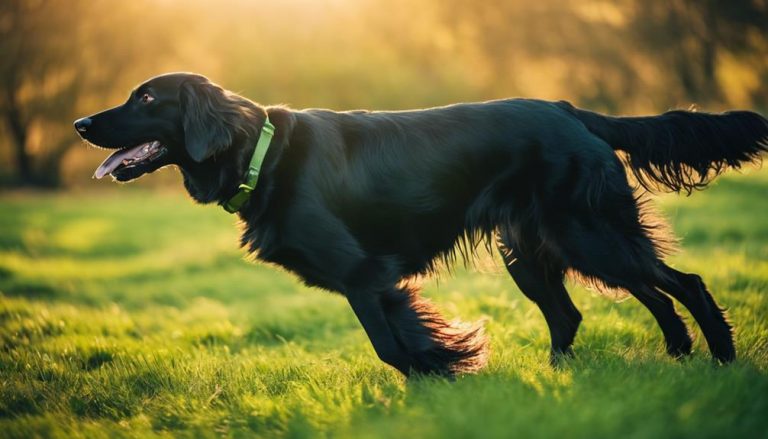Flat-Coated Retriever Breed Characteristics
The Flat-Coated Retriever is a breed that comes from England, dating back to the 1800s. It’s on the larger side for dogs, known for its smooth coat that comes in black, liver, or sometimes yellow. This breed is smart, full of energy, and loves to be around people. They need about 2 hours of exercise daily and enjoy learning new things, which makes training them a fun experience. They have roots in breeds like the St. Johns water dogs, Newfoundlands, and Setters, showing their strong background in retrieving.
When it comes to health, Flat Coated Retrievers are generally healthy, but they do have some risks for certain cancers, hip problems, and eye conditions. Regular visits to the vet are important to keep them healthy. They usually live around 10 to 12 years. Understanding their health and care needs is crucial for anyone thinking of getting this breed.
Key Takeaways
- Originating from England in the 1800s, this breed is both medium and large.
- They showcase a sleek coat in black, liver, or yellow hues.
- These dogs are bright, active, and require regular exercise and grooming.
Quick Facts
The Flat Coated Retriever hails from England and ranks among the medium to large dog breeds. Known for its smartness, lively spirit, and loving nature, this breed shines with its medium-length, sleek coat that lives up to its name. Regular grooming is a must to keep it looking its best. These dogs strike a perfect balance between being energetic workers and cuddly family pets. Thanks to their brains, they’re easy to train and do well in a variety of dog sports, showcasing their adaptable personality.
They typically live for about 10 to 12 years, something to think about for anyone looking for a long-term furry companion. Flat Coated Retrievers need plenty of play and mental challenges to stay happy. Their fun-loving attitude and desire to make their owners happy create an ideal training setting. This makes them a great choice for both first-time and seasoned dog owners.
In essence, the Flat Coated Retriever embodies the best traits of retrievers: loyalty, nimbleness, and a consistently friendly mood. This makes them a beloved member of many families and a proud part of England’s dog heritage.
Overview
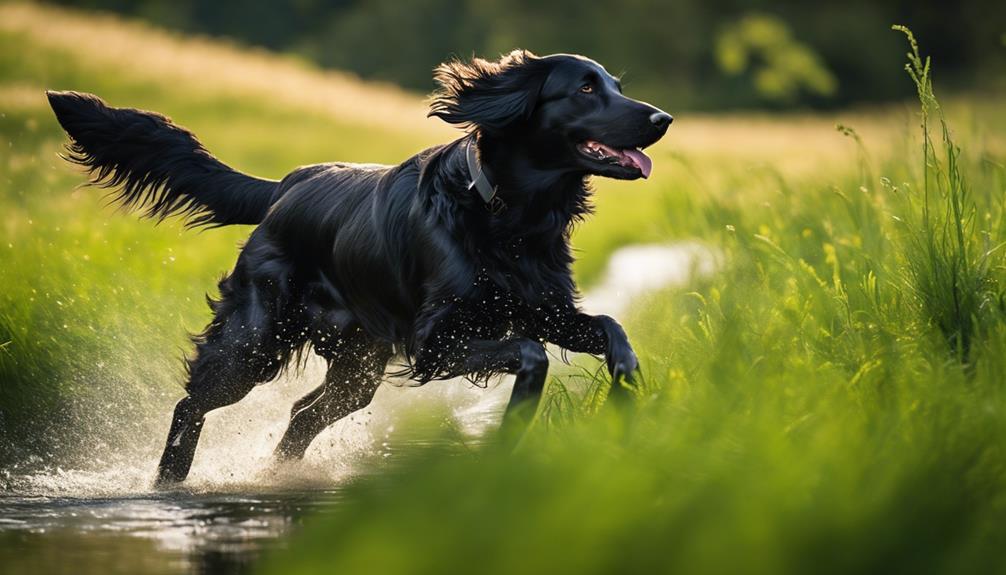
Originating from England in the 19th century, the Flat-Coated Retriever stood out as a medium to large dog breed, becoming a favorite among gamekeepers for its superior retrieving skills on both land and water.
These dogs have a lot of energy and need around two hours of exercise every day to stay healthy and happy. Without enough physical activity, they may develop behavioral problems due to boredom.
This breed is smart and learns quickly, making them great at fieldwork and various dog sports. They are also very affectionate and playful, which makes them excellent family pets. Their love for activity is matched by their joy in spending time with their human companions.
The Flat-Coated Retriever has a medium-length, sleek coat that comes in black, liver, and a rarer yellow color, which is not accepted in show rings. This coat not only gives them their distinctive look but also protects them in both water and on land, underlining their versatility as a retrieving breed.
Energetic and Optimistic Nature
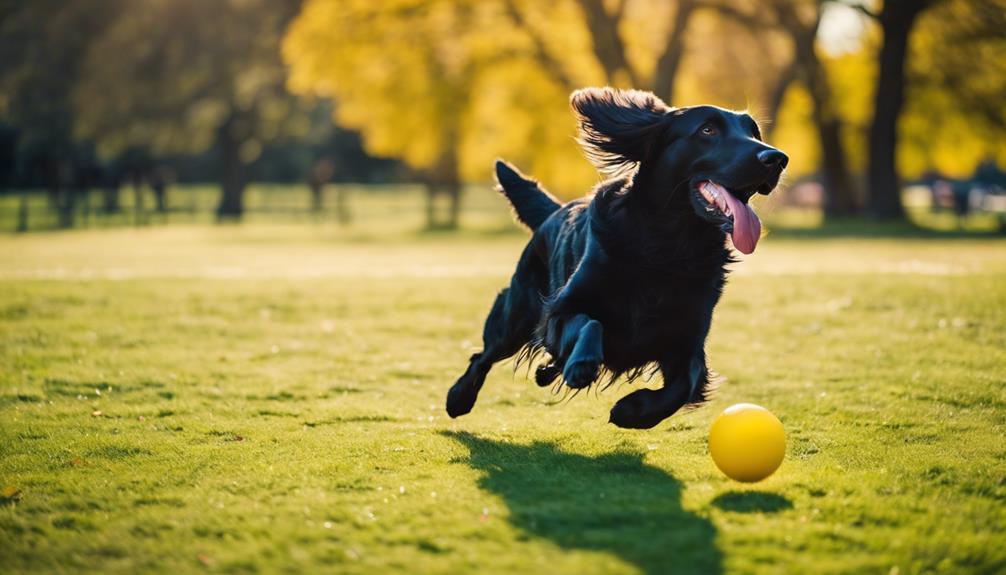
Flat-Coated Retrievers are known for their boundless energy and cheerful attitude, traits that make them perfect companions for those who lead an active lifestyle. These dogs thrive on getting at least 2 hours of exercise every day, which keeps them both physically fit and mentally content. Their love for activity means they’re always up for a run, swim, or game of fetch, making them great partners for outdoor adventures.
Their sunny outlook on life isn’t just nice to have around; it’s essential for their participation in a range of activities. Whether it’s swimming for the sheer joy of it or engaging in canine sports, Flat-Coated Retrievers excel when they can use their brains and bodies together. This need for mental and physical stimulation is why they do so well in environments that offer them plenty of challenges.
Here’s a quick look at how their activities benefit them:
- Running keeps them in great shape and builds endurance.
- Swimming is a fun way for them to exercise without putting too much strain on their joints.
- Playing fetch keeps their reflexes sharp and their bodies agile.
- Participating in canine sports helps them socialize and improve their skills in a competitive setting.
- Mental games are crucial for keeping their minds sharp and solving problems.
9th Century Origins
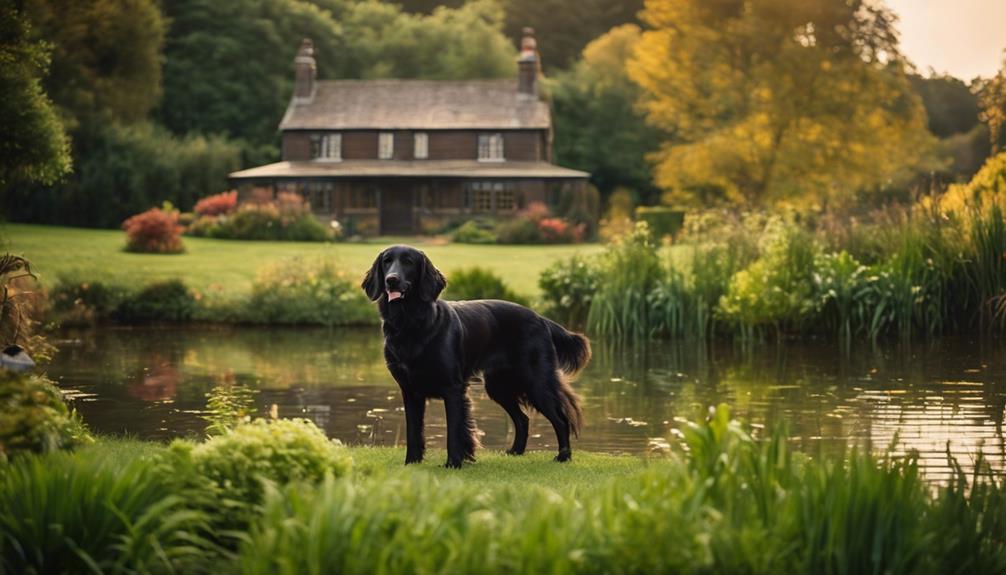
The 19th century was a transformative era for the Flat-Coated Retriever, marking its evolution from a gamekeeper’s aid to a beloved member of the gun dog family. This journey reflects not just changes in the breed itself but also shifts in how dogs were seen and valued in society. The story of the Flat-Coated Retriever begins with its early development, heavily influenced by the crossing of St. Johns water dogs, Newfoundlands, and Setters. These breeds lent their best traits, creating a dog known for its distinctive appearance and capabilities.
The breed’s journey to the United States highlights its appeal as a hunting companion, gaining popularity among enthusiasts for its versatility and temperament. However, its presence was not without challenges. Events like World War II took a toll on the breed’s numbers, leading to a period of decline. Despite this, a resurgence in the 1960s brought the breed back into the limelight, showcasing its resilience and enduring appeal.
Recognition at dog shows, notably Crufts, played a significant role in cementing the Flat-Coated Retriever’s reputation. This acclaim wasn’t just about appearances; it highlighted the breed’s intelligence, friendly nature, and adaptability, traits that have made it a cherished companion beyond the hunting fields.
Early Breed Development
The Flat-Coated Retriever, a breed that originated in England during the 19th century, was initially bred for the purpose of retrieving shot game from both water and land. Originally known as the ‘Wavy Coated Retriever,’ this dog breed was highly valued by gamekeepers for its exceptional ability to retrieve. Breeders at the time were more focused on the dog’s ability rather than its looks, which led to the breed’s characteristic slow maturity and a playful, youthful demeanor well into adulthood. These traits are highly appreciated by dog lovers today.
After facing a decline in numbers due to the impacts of wars, the Flat-Coated Retriever made a strong comeback and became a favored choice as a family pet. This resurgence highlights the breed’s versatility and its continued appeal. The story of this breed’s development showcases a deliberate effort to preserve its natural skills in retrieving while also nurturing its distinct personality.
Historical Significance
The Flat-Coated Retriever has its roots in 19th-century England, where it was a favorite among gamekeepers for its skill in retrieving game from both land and water. This breed combined the best traits of the St. Johns water dog, Newfoundlands, Collie-type dogs, and Setters to meet the demands of hunters needing a versatile dog.
When it arrived in the U.S., the Flat-Coated Retriever quickly became a top choice for hunters because of its exceptional field abilities. However, its popularity waned after World War II but saw a revival in the 1960s, thanks to its success at major dog shows like Crufts. This comeback highlighted the Flat-Coated Retriever’s importance as both a working gun dog and a beloved companion.
Evolutionary Traits
Taking a closer look at the Flat-Coated Retriever, we find a breed with a rich history rooted in 19th-century England. This breed was originally used by gamekeepers, combining the genes of the St. Johns water dog, Newfoundlands, Collie-type dogs, and Setters. This mix gave the Flat-Coated Retriever a unique set of skills, making it an excellent gun dog when it arrived in the U.S. Their popularity dipped after World War II but saw a resurgence in the 1960s, especially after winning at high-profile dog shows like Crufts.
These characteristics show the breed’s ability to adapt and bounce back, highlighting why it remains a sought-after retriever today. The Flat-Coated Retriever’s journey from a gamekeeper’s companion to a beloved pet and show dog illustrates its versatility and enduring charm.
Medium-Large Breed
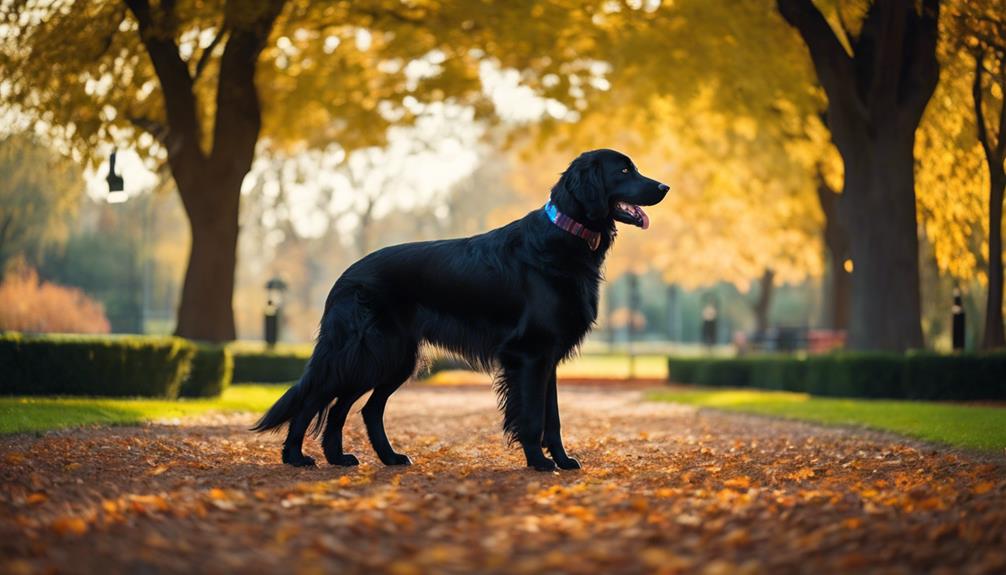
Grasping the essentials of caring for a Flat-Coated Retriever, recognized as a medium-large dog breed, is key for their happiness and health. This section will break down what you need to know if you’re thinking about bringing one of these energetic dogs into your home. We’ll cover the size of the breed, how much exercise they need, health issues to watch out for, and the importance of training and socialization.
Breed Size Overview
The Flat-Coated Retriever stands out due to its size, falling between medium and large. This fact alone dictates a lot about the kind of home environment they’ll thrive in. They need space to move and won’t do well in cramped quarters.
Exercise Requirements
These retrievers are packed with energy, requiring regular, vigorous exercise to stay healthy and happy. A daily routine of long walks, runs, or play sessions is necessary. This not only keeps them physically fit but also mentally stimulated.
Health Considerations
Being aware of potential health issues is crucial for any dog owner. Flat-Coated Retrievers are generally healthy but can be prone to certain genetic conditions. Regular vet check-ups and being alert to changes in their behavior or appearance can catch issues early.
Training & Socialization
Training and socializing your dog from a young age is non-negotiable. These retrievers are intelligent and learn quickly, but they need guidance to grow into well-behaved adults. Socializing them with other dogs and people helps ensure they’re confident and comfortable in various situations.
Breed Size Overview
Flat-Coated Retrievers are in the medium to large dog category, with males standing between 23-24.5 inches and females at 22-23.5 inches. They weigh about 60-70 pounds. These dogs are part of the Sporting Group, which is known for breeds that have a good mix of strength and speed. They’re built for activities that require stamina and quick movements, like hunting.
Their size is a key factor in understanding what they can do and what health issues they might face. Being medium to large dogs means they’re versatile. They can be great family pets, excel in sports, and do well in jobs that require physical activity. This versatility makes them adaptable to different kinds of homes and jobs.
Exercise Requirements
Flat-Coated Retrievers need two hours of exercise every day to stay healthy and happy. This breed loves a good mix of physical activities that keep them both physically fit and mentally sharp. They enjoy long walks, runs, and are particularly fond of swimming, which gives them a thorough workout. Engaging them in dog sports like agility or retrieval games adds a fun twist to their exercise routine by challenging their minds and bodies.
Varying their walking paths and swimming locations keeps their routines interesting. Flat-Coated Retrievers don’t need a lot of space at home, but having access to a secure garden where they can play and relax is crucial.
Health Considerations
When looking at the health of Flat-Coated Retrievers, we need to pay close attention to their higher chances of getting certain cancers like hemangiosarcoma and osteosarcoma. They also face risks of hip dysplasia and eye problems due to their genetics. These dogs are more likely to get other types of cancer, including fibrosarcoma and malignant histiocytosis. It’s a good idea to have them regularly checked for joint issues, hearing problems, and eye conditions. This helps catch any issues early on.
Breeders should make sure their dogs are free from these conditions before breeding. This is to help make sure the puppies are healthy. Epilepsy is another condition that can affect some dogs in this breed. Sadly, the average lifespan of Flat-Coated Retrievers is around eight years. Many of them die from cancer, which shows why it’s so important to keep an eye on their health and get them the care they need.
Training & Socialization
Given the health issues that Flat-Coated Retrievers can face, it’s vital to focus on early training and socialization. This breed needs careful and regular training that uses positive feedback to harness their energy and smarts. Proper training helps keep them mentally sharp and turns them into obedient pets. Plus, introducing them to different dogs, animals, and people early on is key to preventing behaviors like shyness or aggression.
Including mental challenges like puzzles and a variety of training tasks is important. This keeps them from getting bored and makes sure they’re well-adjusted, able to handle different situations.
Grooming Needs
Keeping a Flat-Coated Retriever’s coat shiny and healthy is straightforward but requires regular care. This breed needs weekly brushing to prevent knots and tangles, due to its medium-length, flat coat. Brushing not only helps to keep the coat smooth but also gets rid of dead hair and dirt.
Bathing your dog when necessary, with a shampoo made for dogs, keeps their coat clean without irritating their skin. Grooming isn’t just about the coat, though. It’s also important to clean your dog’s ears and trim their nails regularly to avoid infections and keep them comfortable. If you want your dog to look extra tidy, consider a professional groomer for trimming around the paws and ears. This ensures your Flat-Coated Retriever looks its best.
Joyful Companions
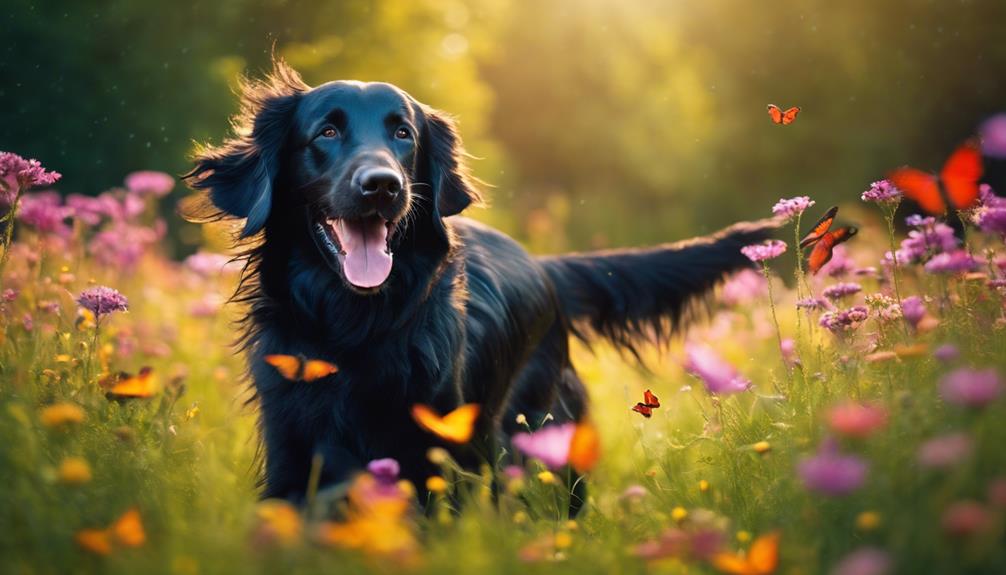
Flat-Coated Retrievers shine as joyful pets, combining their endless zest for life and keen intelligence with a nature that makes them ideal for both households and gatherings. They bring high energy and friendliness to the table, which makes them fun and adaptable companions.
Here’s why they’re great for families and various social settings:
- Boundless Vitality: These dogs are always ready for action, whether it’s a game of fetch or a long hike.
- Friendly Disposition: They love meeting new people and get along well with everyone, making them great for social events.
- Great with Kids: Their gentle and patient nature makes them wonderful pets for families with children.
- Smart and Trainable: With the right approach, training them can be both fun and rewarding due to their intelligence.
These traits make Flat-Coated Retrievers excellent additions to many kinds of homes, proving their worth as both beloved family members and capable working dogs. Their ability to fit into different lifestyles and their eagerness to please highlight their versatility and charm.
Endless Energy Levels
Flat-Coated Retrievers are often seen as the perfect companion dogs for their endless energy and zest for life. They require a good two hours of daily exercise to keep both their bodies and minds in top shape. This breed is perfect for anyone who loves to stay active, as they excel in running, hiking, and various dog sports. They’re not just about physical activities; their sharp minds need engaging too.
Owners of these dogs enjoy a lively and spirited relationship with their pets, always ready for the next fun activity. It’s this combination of physical vigor and eagerness for mental engagement that makes Flat-Coated Retrievers stand out. They’re always enthusiastic about the next challenge, whether it’s a physical activity or a puzzle that tests their intelligence. This makes them more than just pets; they’re partners in adventure and joy.
Social Butterfly Nature
Flat-Coated Retrievers stand out with their joyful nature and love for socializing, making them perfect pets for those seeking a friendly and active companion. Like their close relatives, the Golden Retrievers, these dogs are known for their cheerful and outgoing personalities. They enjoy being around people and other animals, making them great family dogs.
Their willingness to please also makes training them a breeze, fitting well into various social situations. Their positive attitude contributes to their reputation as ideal partners for outdoor activities and gatherings, showcasing their social butterfly nature.
Family-Friendly Traits
The Flat-Coated Retriever shines as a top choice for families, thanks to its happy-go-lucky nature and friendliness. These traits create an inviting atmosphere at home for everyone, from kids to adults. Flat-Coated Retrievers love being around people, making them a perfect addition to any household. They’re especially great for active families, as their energy and playful spirit encourage everyone to get outside and stay active.
These dogs are not just fun; they’re also incredibly patient and gentle with kids. This makes them not only entertaining companions but also trustworthy guardians of your little ones. Their affectionate nature means they quickly become beloved members of the family, strengthening the bond between everyone. In short, the Flat-Coated Retriever’s loving personality and adaptability make them outstanding family pets.
Training and Intelligence
The Flat-Coated Retriever stands out due to its outstanding intelligence and happy-go-lucky nature. This makes it a perfect candidate for varied training routines and engaging in numerous activities. Known for their smart brains, these dogs are always ready to learn new tricks, showing a keenness that makes them adaptable for tasks like obedience, agility, and even as therapy dogs.
To make the most of their abilities, it’s important to keep training sessions energetic and interesting. This approach helps in keeping their minds active and avoids any dull moments. Using positive reinforcement consistently and communicating clearly are key strategies. These methods not only tap into the breed’s intellectual capabilities but also help in building a strong relationship between the dog and its owner, leading to a rewarding training journey.
Health and Longevity
Flat-Coated Retrievers are known for their joyful nature and are generally healthy, but they do need careful attention to avoid certain health issues. They usually live for 8-10 years, and with excellent care, some may even reach 12 years. This breed is more prone to cancer, hip dysplasia, eye problems, and epilepsy than other breeds. Regular vet visits are crucial to catch these conditions early, including checks for joint problems and eye health.
Good breeders will test for genetic diseases to reduce their spread. With attentive care and regular health checks, Flat-Coated Retrievers can lead happy and active lives.
Cancer Risks
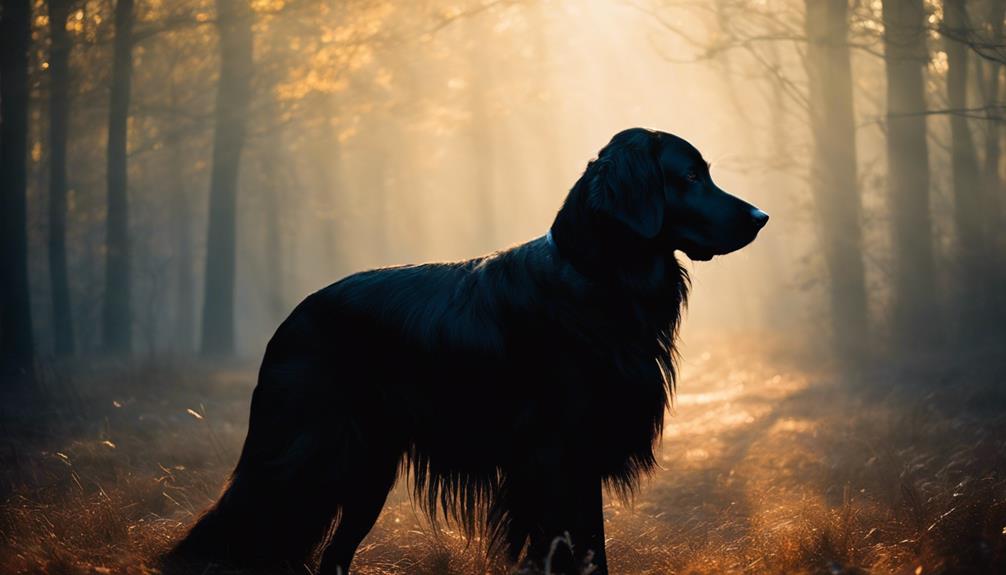
Due to the increased cancer risk in Flat-Coated Retrievers, it’s vital for those who own and breed these dogs to be knowledgeable and proactive about their health care. Recognizing the early symptoms of cancer, taking steps to prevent it, and knowing what treatments are available can significantly impact the health of these beloved pets. Here are some crucial points to consider:
Spotting the early signs of cancer in Flat-Coated Retrievers is the first step. Owners should look out for unusual lumps, sudden weight loss, or changes in behavior and appetite. Preventing cancer can involve strategies like a healthy diet, regular exercise, and avoiding exposure to known carcinogens.
Understanding the various treatment options for dogs diagnosed with cancer is also essential. Treatments may include surgery, chemotherapy, radiation, or a combination of these, depending on the type and stage of cancer. The importance of regular vet check-ups can’t be overstated, as early detection often leads to better outcomes.
Identifying Cancer Symptoms
Understanding the risks of cancer in Flat-Coated Retrievers is crucial due to their susceptibility to various types of malignancies. This includes hemangiosarcoma, fibrosarcoma, osteosarcoma, and malignant histiocytosis. Spotting early symptoms is key to managing these risks effectively.
Owners should watch out for signs like unusual lumps, swelling, sudden weight changes, or shifts in appetite. These could indicate the onset of cancer. Regular vet visits are essential for catching these symptoms early. Being alert to any changes in your dog’s normal health, such as ongoing weight loss or different eating habits, is vital.
Catching these signs early and getting to a vet quickly can greatly improve the chances of a positive outcome. It’s all about being proactive in looking after your Flat-Coated Retriever’s health, especially when it comes to cancer.
Preventive Health Measures
To reduce the high cancer risk in Flat-Coated Retrievers, it’s crucial to adopt thorough health measures. Given their tendency to develop diseases like hemangiosarcoma, fibrosarcoma, and osteosarcoma, regular vet visits are vital. These check-ups are key for early cancer detection and monitoring.
Breeders also play a crucial role in minimizing cancer risks in future generations through health screenings. Knowing the breed’s genetic risks helps in creating specific prevention plans. Taking these steps seriously helps ensure Flat-Coated Retrievers live healthier, longer lives.
Treatment Options Available
Given the high cancer risk in Flat-Coated Retrievers, it’s crucial to consider the treatment options available for managing this common health concern. These dogs are prone to cancers like hemangiosarcoma, fibrosarcoma, osteosarcoma, and malignant histiocytosis.
Early detection is key to managing cancer in these dogs. Regular vet visits help catch the disease early, allowing for timely treatment. Treatments may involve surgery, chemotherapy, radiation, or a mix, depending on the cancer type and stage.
Breeders should test for health conditions to reduce the chance of passing on cancer risks. Teaching owners about these risks helps them make better healthcare choices for their dogs. The goal is to improve their lifespan, given that cancer is a major reason why these dogs often live only about eight years.
Grooming Essentials
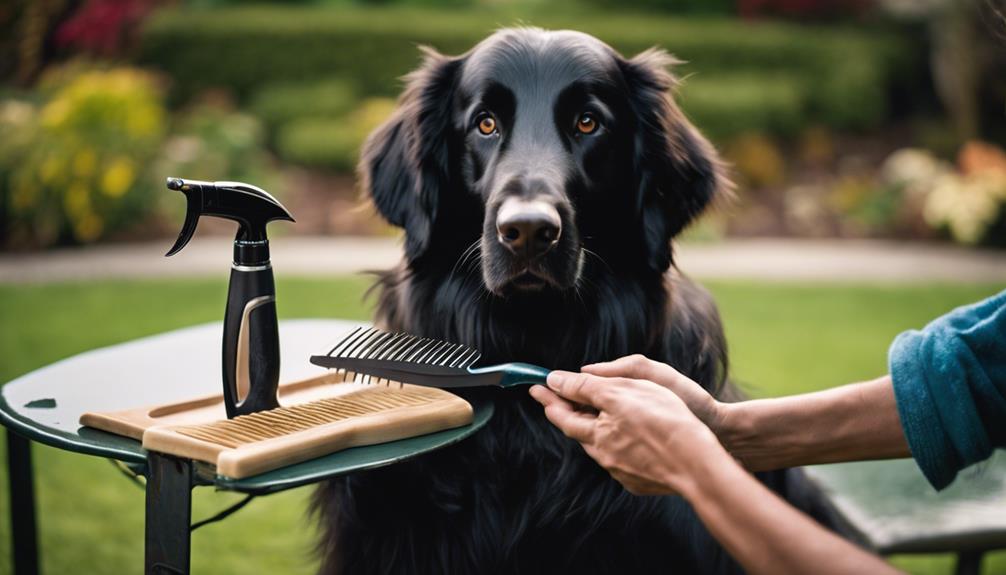
To ensure your Flat-Coated Retriever stays in top shape, it’s vital to get a handle on grooming essentials. In this guide, we’ll cover everything from basic coat care to the nails and ears, with tips on how to adjust your grooming routine with the seasons to keep your dog’s coat shiny and healthy all year round.
Basic Coat Care involves regular brushing to remove dirt and loose fur, which helps prevent matting. For a Flat-Coated Retriever, whose coat is dense and water-repellent, using a slicker brush and comb can be particularly effective.
Brushing Techniques are crucial. For this breed, brushing a few times a week with the right tools can significantly reduce shedding and keep the coat smooth. Remember to be gentle to avoid skin irritation.
Deciding on the Bathing Frequency is next. While it’s tempting to bathe your dog often, over-bathing can strip the coat of natural oils. For Flat-Coated Retrievers, a bath every two to three months is usually sufficient, unless they get particularly dirty.
Nail and Ear Care shouldn’t be overlooked. Trim nails regularly to prevent discomfort and check the ears weekly for signs of infection, especially since this breed loves to swim.
Adjusting grooming practices for seasonal changes is also key. In warmer months, you might need to brush more frequently to help your dog stay cool. Conversely, during colder months, pay extra attention to the paws and undercoat to maintain insulation and protection from the elements.
This approach to grooming not only keeps your dog looking great but also supports their overall health, making it a crucial aspect of pet care.
Basic Coat Care
Taking care of a Flat-Coated Retriever’s coat is pretty straightforward but requires consistent effort. Their medium-length, sleek coat can get tangled and matted if not groomed regularly. Brushing their coat around 2-3 times a week helps spread the dog’s natural oils, keeping their fur healthy and reducing the amount of hair they shed. It’s also a good idea to give them baths with a shampoo made for dogs to keep their coat clean and vibrant.
When grooming, don’t forget to trim the fur on their feet, ears, and tail. This helps keep them looking neat and prevents mats from forming in these areas, which can be more prone to tangling. Always check for ticks, burrs, or any debris during grooming sessions. These can be uncomfortable for your dog and might lead to health issues if not addressed. Regular grooming will ensure your Flat-Coated Retriever’s coat stays shiny and healthy.
Brushing Techniques
Proper grooming techniques are key for maintaining the coat of a Flat-Coated Retriever. This breed’s thick fur needs weekly brushing to remove loose hair and prevent tangles. For the best results, use a slicker brush or a grooming rake. These tools are designed to get through the thick coat and pull out dead hair from the undercoat.
Pay extra attention to the fur on the legs, chest, and tail. These areas are more likely to get knotted. Regular brushing keeps the coat shiny by spreading the dog’s natural oils and allows you to check the skin for any problems. This routine is essential for the health and appearance of your dog.
Bathing Frequency
For the health and shine of a Flat-Coated Retriever’s coat, bathing them every 6-8 weeks is key. This schedule helps keep their unique water-resistant double coat in top shape without stripping away the natural oils that give it sheen and protection.
Washing them too often can harm their coat and skin. Using a high-quality dog shampoo made for their coat type will help keep it smooth and prevent tangles, especially in their long, feathered areas.
After a bath, it’s crucial to dry them well to avoid any skin issues and keep their coat looking its best.
Nail and Ear Care
Maintaining the nails and ears of Flat-Coated Retrievers is crucial for their health and comfort. This includes regular trimming and weekly inspections to fend off overgrowth, discomfort, and possible infections. When it comes to nail care, precision is key because long nails can cause pain and affect the dog’s posture and daily activities. It’s important to trim carefully to prevent cutting into the quick, which can be painful and cause bleeding.
For ear care, keeping an eye out for signs of infection or too much wax is essential, as these are common problems for this breed. A weekly check-up to make sure the ear canal is clean and dry can help prevent infections caused by bacteria and yeast, avoiding more serious health issues. These grooming practices are not just about keeping your retriever healthy; they also strengthen the bond you share through regular care routines.
Seasonal Grooming Tips
Knowing how to properly take care of a Flat-Coated Retriever’s coat through the seasons is key to keeping them healthy and looking their best. Their medium-length coat requires regular grooming, but when shedding increases, so should your brushing routine to keep up with their hair loss.
It’s best to bathe them only when necessary to avoid stripping the coat of its natural oils. Pay extra attention to their ears and eyes to prevent infections. Using the right tools, like slicker brushes and combs, is crucial for maintaining the health and appearance of their coat.
Following these steps will keep your Flat-Coated Retriever looking sharp.
Dietary Needs
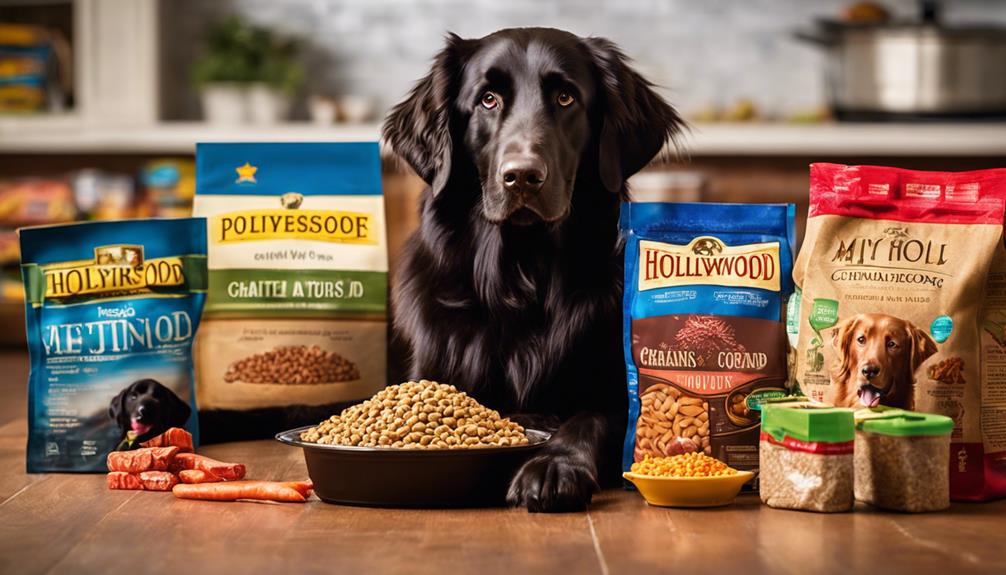
Caring for Flat-Coated Retrievers involves paying close attention to what they eat. A well-thought-out diet is essential for keeping them energetic and at a healthy weight while also preventing common health issues. It’s crucial to focus on a few key areas when planning their meals.
Balanced nutrition is the cornerstone of a healthy diet for these dogs. They need the right mix of proteins, carbohydrates, fats, vitamins, and minerals to support their active lifestyle. Keeping an eye on their weight is also important since obesity can lead to serious health problems.
Recognizing food allergies can make a huge difference in a Flat-Coated Retriever’s quality of life. Some may have sensitivities to certain ingredients, which can affect their health if not addressed. Therefore, it’s beneficial to work on a custom diet plan that caters to their specific needs, considering any allergies or sensitivities they might have.
Balanced Nutrition Essentials
For Flat-Coated Retrievers, a balanced diet with plenty of quality protein is key to muscle growth and energy. It’s important to include vital nutrients like Omega-3 fatty acids to keep their skin and coat healthy. These dogs can easily gain weight, so it’s critical to watch their calorie intake closely. Setting a regular feeding routine and controlling portion sizes can help maintain their ideal weight.
You should also consider getting advice from a vet, who can suggest a diet plan that’s right for your dog’s age, how active they are, and their health needs. This approach makes sure your Retriever gets the right nutrition for their overall health.
Managing Weight Concerns
Managing weight concerns for Flat-Coated Retrievers requires a dual approach: a well-balanced diet and consistent exercise. These dogs need their meals to be precisely measured and scheduled to avoid weight gain.
It’s essential to choose premium dog food that provides the right amount of protein and nutrients for their health. Regular physical activities are equally crucial for keeping them in shape.
Given the breed’s unique requirements, seeking advice from a vet or a dog nutrition expert is a smart move. They can help craft a diet plan that specifically addresses the dog’s needs, ensuring they lead a healthy and active life.
Food Allergies Identification
For Flat-Coated Retrievers, a balanced diet and regular exercise are key. But spotting and handling food allergies is just as crucial for their well-being. Allergies can show up as skin problems, stomach upset, or constant scratching. To find out what’s causing the issue, vets often recommend cutting out certain foods one by one or conducting allergy tests. Common triggers include ingredients like beef, chicken, dairy, and grains such as wheat and corn.
Keeping a close eye on what your dog eats and how they react can make a big difference. Writing down every meal and snack in a food diary helps track down the culprit. It’s also a good idea to work with a vet who specializes in animal nutrition. They can help create a diet plan that avoids allergens while keeping your dog healthy and happy.
Frequently Asked Questions
Is a Flat-Coated Retriever a Good Pet?
- Pleasant nature makes them great family pets.
- Needs regular exercise to stay happy.
- Compatible with various family setups.
Are Flat-Coated Retrievers Good Service Dogs?
- Service dogs need to be smart, calm, and adaptable.
- Training is key to prepare them for demanding tasks.
- Challenges must be overcome for successful service work.
Is a Flat-Coated Retriever Rare?
- Ranked 103 out of 201, it’s not very common.
- Research before finding a breeder is crucial.
- Its uncommon status appeals to dog lovers.
Are Flat-Coated Retrievers High Maintenance?
- Grooming needs keep their coat healthy.
- Daily exercise controls their energy.
- Mental activities keep them happy.

